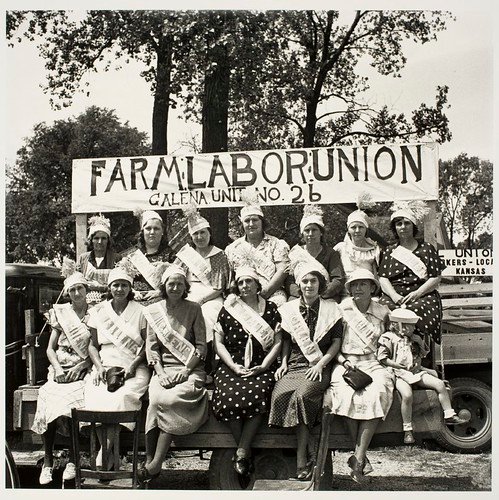Labor Day, first celebrated in 1882, was created to honor the social and economic achievements of American workers. Fair hours, equal(ish) pay, nondiscriminatory practices, and paid leave were all born from the rise of the labor union movement in the late 1800s. The success of this movement was due in no small part to the fiercely powerful women at the front of the picket lines and leading political policy. This fight continues today.
Since the birth of the first women’s labor union in 1834, groundbreaking and stereotype-defying women have fought to ensure fair and equal rights for themselves and the women will who come after them. This Labor Day, we recognize just a few of the thousands of politicians, orators, balladeers, activists, organizers, and scholars that have played a role in advancing women’s role in American labor and society.
Hattie Canty

The New Yorker, February 26, 1996, p. 147-48
Hattie Canty (right) became active in Las Vegas, Nevada’s Culinary Workers Union Local 226 in the late 1970s. She was elected to the local executive board in 1984. That same year, they staged a 75-day walkout to improve health insurance for casino workers. One year after Canty became union president, the union began the longest labor strike in American history. Canty worked to ensure a living wage, union integration, and greater job opportunities for people of color.
May Chen

May Chen/PBS
Officer and founding member of the AFL-CIO’s Asian Pacific American Labor Alliance (APALA), May Ying Chen, led the New York Chinatown Strike in 1982. Approximately 20,000 garment workers marched the streets of lower Manhattan demanding work contracts in one of the largest Asian American worker strikes in U.S. history. Chen joined the International Ladies’ Garment Workers’ Union, inspired by the strike, and began working on the ILGWU Immigration Project in 1984.
Velma Hopkins

New Jersey State AFL-CIO
Velma Hopkins was a member of the Local 22 of the Food, Tobacco, Agricultural, and Allied Workers of America-CIO in the 1940s, where she fought for better conditions for African American workers in Winston-Salem, North Carolina. She helped mobilize 10,000 workers into the streets in an effort to bring unions to R.J. Reynolds Tobacco Company, the only time in its history the company had a union.
Luisa Moreno

National Museum of American History/Wikimedia Commons
Guatemalan-born labor organizer and civil rights activist, Luisa Moreno, led a strike in 1930 against Zelgreen’s Cafeteria in New York City. Facing a police barrier in front of the cafeteria, Moreno strolled past in a fur collar coat as if she were going to enter. Once at the door, she pulled a picket sign from under her coat and thrust it in plain view. Police carried her to a nearby building; she came out with her face bleeding. Moreno considered herself fortunate that she wasn’t disfigured.
Florence Reese

Special to People’s World/People’s World
Florence Reese wrote the hauntingly powerful folk ballad, Which Side Are You On, after she and her children were terrorized by deputies searching for her husband, Sam Reece. The men were hired by the local mining company to kill Sam, a striker and union organizer for United Mine Workers in Harlan County, Kentucky in 1931. Billy Bragg, Natalie Merchant, Ani DiFranco, and several other artists have since offered their interpretations of the labor union song.
Emmy Tenayuca

American Postal Workers Union/University of Texas San Antonio
Born in San Antonio, Texas, Tenayuca became known as “La Pasionaria de Texas” through her work as an educator, speaker, and labor organizer. Between 1934 and 1938, she attended almost every strike in San Antonio, wrote and distributed leaflets, and visited strikers’ homes. Tenayuca joined the communist party and Workers Alliance in 1936, where she fought for a minimum wage law and the right of Mexican workers to strike without fear of deportation.
Clayola Brown

Pennsylvania AFL-CIO
At just fifteen years old, Clayola Brown joined her mother in a successful campaign to bring the Textile Workers Union of America to the Manhattan Shirt Factory in Charleson, South Carolina. Seven years late in 1970, Brown was hired by TWUA where she went on to play an organizing role in a 17-year struggle with textile giant, J.P. Stevens. Over 3,000 workers won a contract through the newly formed Amalgamated Clothing and Textile Workers Union due to TWUA and Brown’s efforts.
Ai-Jen Poo

U.S. Department of Labor/Wikimedia Commons
Ai-Jen Poo began her work in organizing in 1966 with the Women Workers Project at the Committee Against Anti-Asian Violence. In 2000, she co-founded New York City-based Domestic Workers United, where she worked for nine years to provide opportunities for domestic workers to share their experiences and seek appropriate legal counsel. In 2010, New York state legislature passed the Domestic Workers Bill of Rights, granting domestic workers the same lawful rights as other employees, including vacation time and overtime pay.
Mary Lease

Wikipedia
Mary Elizabeth Lease’s captivating public speaking skills and fierce determination helped push her to the forefront of the midwest Populist movement of the late 1800s. She is quoted as saying, “you may call me an anarchist, a socialist, a communist, I care not, but I hold to the theory that if one man has not enough to eat three times a day, and another man has 25 million dollars, that last man has something that belongs to the first.”
Jennifer Epps-Addison

Screenshot from Youtube
Named an ‘activist to watch‘ in 2013, Jennifer Epps-Addison currently serves as the president and co-executive director of the Center for Popular Democracy and CPD Action’s network of 49 partner organizations across 33 states. She played a central role in winning campaigns like in-state tuition for children of undocumented parents and paid sick days. Epps-Addison also led a campaign as head of Wisconsin Jobs Now that helped pass a living wage ordinance through the Milwaukee County Board.
